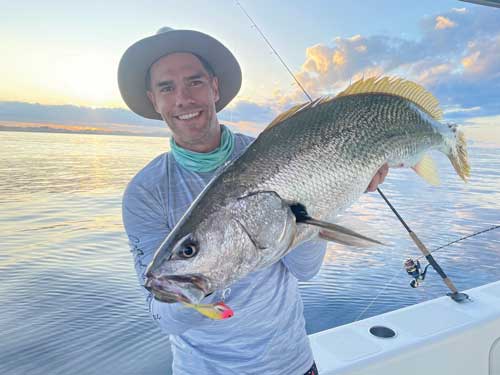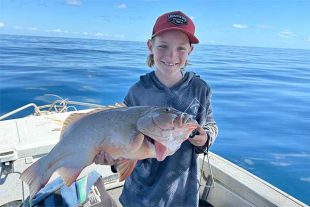Winter is snapper time in southeast Queensland and since the introduction of the closed season from mid-July to mid-August, June is the month to chase a few.
The cooler water temperature and light southerly wind that we typically experience during June are perfect conditions for schooling snapper to feed and spawn.
Snapper are an incredible fish, particularly when you consider they inhabit shallow inshore reefs and estuaries in water only 1m deep, as well as the continental shelf and depths of up to and sometimes in excess of 220m.
The diversity in their habitat means that there are a stack of different techniques and tactics that can be used to catch these prized fish, however there are a couple that anglers keep coming back to.
Float lining
Without a doubt, the most traditional way to catch snapper is by ‘float lining’ lightly weighted bait through the water column.
This technique has stood the test of time for one simple reason… it’s incredibly effective.
Snapper will leave structure to feed, particularly in low-light periods, and will rise through the water column in the presence of food.
A well-presented and consistent berley trail will typically attract the majority of fish in an area, it’s then only a matter of presenting your bait as naturally as possible within the feeding frenzy.

The rig to use is simple – a running ball sinker on a set of gangs, snelled or even a single hook.
I like to use a green glow bead between the sinker and top hook to protect the knot because big snapper have strong jaws that will typically bite down on your hooks and easily slice through your knot.
The weight of your sinker is determined by the depth of water you’re fishing in, the current and wind speed.
As a rule, you’ll want to use a sinker that will get your bait to the bottom as slowly and as natural looking as possible.
Float lining is most effective at anchor, especially when employing a berley trail.
I prefer to use a star drag overhead, such as a Shimano Trinidad or Torium, slowly feeding out the monofilament line so that the bait descends at a 45-degree, or thereabouts, angle from the boat.
In my opinion, mono line has a distinct advantage over braid when float lining due to two key factors.
First, mono sinks and braid floats, so mono will allow for a more natural bait presentation.
Second, when a snapper strikes, the stretch of mono becomes your best asset.
As line starts to peel off the reel, allow the fish to run for a second or two and then engage the drag.

The engagement of the drag and the strike from the angler puts a significant amount of pressure on the hooks, and the stretch component of the monofilament line acts as a shock absorber, meaning you’ll set the hooks more effectively and limit the chances of pulling them clean out of the snapper’s mouth.
When float lining, target the low-light periods of slightly before and after sunrise and sunset.
Depending on the moon phase, the snapper bite can be hotter in the morning or the afternoon/evening.
You can float line in any depth however, to do it effectively, focus your efforts in depths ranging between 10-70m.
Anything over 70m starts to become difficult, simply due to the current and the time it takes to slowly drift bait down to the bottom third of the water column.
Bait wise, squid, pilchard, prawns and flesh will all work.
Try to match your bait with what’s in your berley trail.
Though ensure your bait is big and well-presented, whereas your berley is the minced version – on descent, this creates a cloud of oil that carries small specks of pilchard, mullet or squid.

Lures
It’s fair to say that soft plastics and vibes have revolutionised the way anglers go about chasing snapper.
The versatility of these lures in any depth makes them a perfect offering for a hungry knobby.
The technique adopted when using lures has many similarities to that of float lining.
The principal of fishing as light as possible yet still reaching the bottom with your lure is probably the biggest.
Jig head or vibe weight selection is crucial and again is determined by water depth, wind and current.
Unlike when float lining, you want to be drifting when using lures.
Locate a school of fish, drive upwind or up current and drift back onto them, casting your lure way out in the front in the direction your boat is drifting.
Work your lure in the bottom third of the water column until the boat drifts on top of it and you’re vertically jigging.
As it drifts out the back, wind in, cast in front of the boat and repeat the process.
Most of the time, snapper will hit the lure on the drop – either during the initial decent or after you’ve hopped it off the bottom.
If you feel an eat through your slack line, engage the reel and strike.
Soft plastics can be fished in almost any depth, simply change your jig head weight to suit.
Jerk shads in 5” and 7” are very popular, though other fish and prawn imitations can be just as effective.
My preference is to use soft vibes over hard, so I tend to stick with the Squidtrex and Vertrex ranges from Nomad Design.
June will fly by and before you know it, snapper will be off the menu for a month.
So, now is the time to keep an eye on the weather, line up a glassy day, get up early (or stay up late) and nail a few southeast Queensland winter snapper.
Catch you.
 Bush ‘n Beach Fishing Magazine Location reports & tips for fishing, boating, camping, kayaking, 4WDing in Queensland and Northern NSW
Bush ‘n Beach Fishing Magazine Location reports & tips for fishing, boating, camping, kayaking, 4WDing in Queensland and Northern NSW









